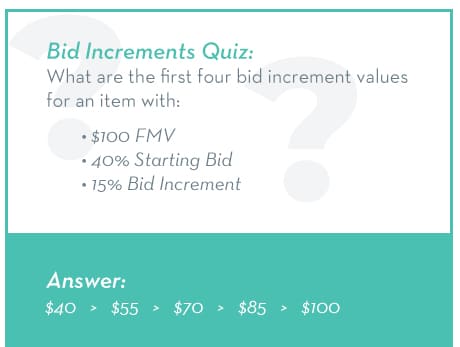Pricing Items for Your Virtual Auction: 4 Key Steps

Which new strategies that you adopted in 2020 effectively generated support, engaged donors, and reached new audiences? Chances are virtual events have played a role in your COVID-era tactics. The pivot towards virtual events has been a particularly challenging but (hopefully) rewarding experience for many organizations.
After all, this is brand new ground for many nonprofit teams, so there have been plenty of lessons and best practices to learn.
For nonprofits looking to expand their virtual event offerings in the Spring 2021 season, we highly recommend virtual auctions. These events have proven time and again to be effective choices for organizations of all sizes because they’re more cost-effective and flexible than their traditional, in-person counterparts.
However, the critical importance of the item pricing process is a major commonality between virtual and traditional auctions. How you price the items that you offer to bidders directly impacts your auction’s ability to recoup and exceed its costs.
At OneCause, we’ve helped thousands of nonprofits navigate the world of charity auctions over the years, including many venturing into the world of virtual fundraising for the first time. We’ve learned plenty of tricks along the way for handling item pricing, which is an especially high-stakes part of the planning process. Let’s review the essential steps to follow:
- Determine each item’s fair market value.
- Set the perfect starting bid for each item.
- Determine each item’s minimum raise amount.
- Boost revenue with buy-it-now options.
For a detailed walkthrough of the complete process, our guide to auction item pricing covers each of these steps in-depth. For now, we wanted to share the most important takeaways for nonprofits considering hosting a virtual auction in the coming year. Let’s dive in.
Step 1: Determine each item’s fair market value.
An item or package’s fair market value (FMV) is the foundation of the full pricing strategy that you’ll lay out for it.

Fair market value is the selling price that buyers and sellers can easily agree upon. For silent, live, and virtual auctions alike, the FMV is essentially what people would be willing to pay for each item in a typical buying context, and it’s the value that bids will need to exceed in order to generate high ROI for your auction.
For physical items and packages of tangible goods, determining FMV is fairly easy. Retail prices of items and cash values of gift certificates are the most straightforward examples.
For more unique yet still tangible items that don’t have definite retail prices (like memorabilia), the pricing process might involve a bit more research. We recommend researching on eBay, consulting with other nonprofits that have offered similar items at their auctions, and discussing with the individuals or donors that donated the items. If you’ve partnered with an auction item consignment service, they should recommend a pricing strategy.
However, intangible auction items pose a particular challenge when determining FMVs. These typically include items or packages that involve unique services or experiences, ranging from celebrity meetups to spots in a donor recognition garden. Even though it’s difficult to gauge a concrete value for these types of items, determining an FMV is still essential for maximizing each item’s return. Here are a few tips for appraising intangible auction items:
- Examine your results from previous auctions. Did you offer similar intangible items? If so, how did you value them and how much did they raise? Which types of items generated the most bids? These insights are the most immediately useful when it comes to pricing intangible items.
- Study your audience demographics. Who are your typical donors and attendees? What are their ages, interests, and income levels? These guidelines can also be extremely helpful when estimating what your particular donors would be willing to pay.
- Consult with supporters and peers. Effective pricing is critical, so don’t be shy about asking for people’s thoughts on appropriate prices for intangible items. Your staff, nonprofit peers, and major donors might all have useful insights. And don’t forget to get your board involved! Ask them to leverage their own community connections to get feedback on estimated prices for select items.
Get a headstart on the pricing process by determining fair market values as your team procures items (rather than all at once later). Your pricing strategies are central to your auction’s success, so giving yourself plenty of time to refine them leading up to the virtual launch is never a bad idea.
Step 2: Set the perfect starting bid for each item.
The starting bid is the initial amount that each item’s bidding begins at. While auction newcomers might be tempted to make rough guesses about ideal starting bids for each item, careful thought needs to be put into this step.
This is because your items’ starting bids will greatly impact how your bidders begin engaging with your auction. Strong engagement is especially critical for virtual fundraising events since attendees will be facing more at-home distractions or interacting with you over a longer timeframe (like in a weeklong virtual auction). Your starting bid amounts will play a major role in either getting the ball rolling or inadvertently discouraging bidders from jumping in.
While setting starting bids for auction items isn’t an exact science, there are a few concrete rules of thumb that pros follow when planning auctions. Remember these guidelines:
- Most auction items’ starting bids should be between 30-50% of their fair market values. This range will help you strike the right balance between starting too low (and reducing ROI) and starting to high (which will decrease engagement overall).
- For less popular or run-of-the-mill items that likely won’t generate as much interest as your main attractions, stick to the lower range of around 30% of FMV.
- For your showstopping items, rare offerings, and most unique packages, aim higher with a starting bid of roughly 40-50% of their FMVs. If you know an item will naturally generate more competition, you can safely assume a higher starting bid won’t significantly decrease engagement.
Keeping these guidelines in mind, look closely at each of your auction items to narrow their starting bids down even further. You’ll need to consider a few additional factors including:
- Audience demographics. Based on what you know about your donors, avoid starting bids that might be immediately out of budget for many of your bidders.
- Bargain mentality. Everyone loves feeling like they’re getting a good deal, so tap into that bargain mentality with lower starting bids. This tactic is most useful for low- or mid-range items that won’t be the stars of the show on their own.
- Emotional connections. Some items, like memorabilia, might be especially meaningful for your donors, who’d then be willing to start bidding at slightly higher starting bids.
Remember, your starting bids set the tone for how bidders will engage with your auction and ultimately drive revenue for your mission. Create momentum and excitement by thinking carefully about each item’s starting bid using these guidelines and factors.
Step 3: Determine each item’s minimum raise amount.
While your bidders will be able to choose exactly how much they want to offer for your items, you’ll need to set the minimum rate by which bids must increase. Like determining an FMV and appropriate starting price, your items’ minimum raise amounts will play important roles in determining how much revenue they can ultimately generate.
As a general guideline, your minimum raise amount should be between 10-15% of its FMV. For your most expensive items, aim for the lower end of this range to ensure that bids don’t grow so large that they begin decreasing interest.
Here’s a quick quiz to illustrate a complete pricing strategy:

This basic example brings up a critical point to keep in mind: The rate by which bids increase for each item will determine how many bids are needed to make up its complete value.
The 40% starting bid and 15% minimum raise amount (or bid increment) in the example above means it will take only 3 separate bids for the item to recoup its value. Any additional bids will then serve to increase your event’s ROI and generate more revenue for your mission.
Understanding this point can be a gamechanger for your virtual auction since you’ll be able to set specific bidding goals for each item and then actively direct attention where it’s needed. For instance, if an item needs 5 minimum raise bids to reach its FMV but has only received 2, use announcements and push notifications to spotlight the item and gin up some competition!
Here’s a pro tip to keep in mind when determining bid increments for your auction: If an item requires more than 5 to 8 minimum raise bids to reach 70% of its FMV, your bidding increments are too low and may prevent you from generating ROI with that particular item.
Finally, you’ll need to consider how exactly the bid increment process will work from your bidders’ perspectives. Virtual auction software should make it easy to preset your minimum raise amounts for each item, meaning minimum bids will automatically populate for bidders to consider within your online catalog or mobile bidding tools.
Step 4: Boost revenue with buy-it-now options.
As you begin finalizing your auction item catalog and pricing strategies, consider offering bidders the option to simply purchase several of your lower and mid-range items. This tactic has a few valuable benefits:
- Buy-it-now options can be an extremely easy way to open up avenues for increased revenue if the majority of your bidders are focused on your main attraction items.
- It also gives impatient or particularly motivated bidders the option to bypass the competition completely, giving them a more satisfying experience.
- The sight of your item catalog shrinking as bidders take advantage of buy-it-now options can create a compelling feeling of scarcity, driving more activity to your remaining items.
If you choose to offer buy-it-now options during your virtual auction, set the price at 150-200% of each item’s FMV. Just remember that an item’s natural bidding total shouldn’t exceed its buy-it-now price, meaning items that you expect to generate a lot of competition and interest should be excluded from this strategy.
This tactic can be useful beyond boosting your auction’s revenue, too. Bidders who are willing to pay top dollar for the items they like (while also supporting your mission in the process), might make excellent candidates for your nonprofit’s broader prospect research efforts. After your auction wraps up, take a look at exactly who took advantage of your buy-it-now options. Do they have anything in common? This approach can help give you predictive insights based on how donors actually interact with your nonprofit rather than going on wealth data alone.
To simplify the entire item pricing process, your virtual auction toolkit will need to actively support your efforts.
By using silent and online auction software (that includes mobile bidding tools), you should be able to both dramatically streamline the pricing process on your end and improve the user experience for your bidders. Easier-to-use tools means more refined pricing strategies, increased bidder engagement, and more revenue for your mission.
Here’s the biggest takeaway: As your next virtual auction begins taking shape, do not neglect the item pricing process. How you price your items, including their FMVs, starting bids, and minimum raise amounts, will directly impact your event’s ability to generate a positive ROI. Following these industry best practices will help ensure a more impactful virtual auction for your nonprofit. Best of luck!



